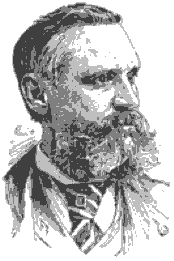Peter Dirck Keyser | |
|---|---|
 | |
| Born | February 8, 1835 Philadelphia, Pennsylvania |
| Died | March 9, 1897 (aged 62) Philadelphia, Pennsylvania |
| Education | |
| Occupation | Ophthalmologist |
| Signature | |
 | |
Peter Dirck Keyser (February 8, 1835 – March 9, 1897[1]) was a United States ophthalmologist.
Biography
Peter Dirck Keyser was born in Philadelphia, Pennsylvania on February 8, 1835.[2]
Studies
He studied at Delaware College until 1851, when he entered the chemical laboratory of Frederick A. Genth, and there made analyses of minerals, the results of which were published in the American Journal of Science, and were afterward incorporated in Dana's Mineralogy. In 1856 he went to Germany and pursued professional studies for two years.
Civil War service
Soon after the beginning of the Civil War he became captain in the 91st Pennsylvania Regiment, and served with the Army of the Potomac until after the Battle of Fair Oaks. Failing health then led to his resignation.
He returned to Germany, where he studied at the University of Munich, and then at that of Jena, receiving there the degree of M.D. in 1864. On his return to the United States, he was appointed acting assistant surgeon in the U.S. Army, and was detailed to Cuyler Hospital in Germantown, Pennsylvania. In 1865 he resigned from the service to enter on his private practice.
On April 15, 1865, Keyser was one of three co-founders of the Military Order of the Loyal Legion of the United States, or MOLLUS. It was the first post-Civil War veterans' organization, and was open to men who had served in the suppression of the Rebellion and who had held a commission in the armed forces of the United States. He was assigned MOLLUS insignia number 00003. The organization exists today, composed largely of the descendants of those officers.
Medical practice
He became director of the Philadelphia Eye and Ear Infirmary. In 1868 he delivered a course of lectures to physicians upon the accommodation and refraction of the eye, and in 1870 he delivered the first regular course of clinical lectures on ophthalmology that ever was given in Philadelphia, repeating the course in 1871–72. Keyser was elected ophthalmic surgeon to the medical department of the Philadelphia German Society in 1870, and one of the surgeons to the Wills Ophthalmic Hospital in 1872.
Memberships and writings
Keyser was a member of medical societies and of the Pennsylvania Historical Society, and he was a contributor of medical papers to the journals of his profession both in the United States and Europe. His earlier works were on chemistry; later he published Report on Operations for Cataract (1874), and other papers in the same field.[3]
Death
Peter Dirck Keyser died at his home in Philadelphia on March 9, 1897.[4]
Notes
- ↑ "91st PA:Peter Dirck Keyser". ancestry.com. Retrieved September 22, 2011.
- ↑ The National Cyclopaedia of American Biography. Vol. IV. James T. White & Company. 1893. p. 292. Retrieved December 5, 2020 – via Google Books.
- ↑
 One or more of the preceding sentences incorporates text from a publication now in the public domain: Gilman, D. C.; Peck, H. T.; Colby, F. M., eds. (1905). "Keyser, Peter Dirck". New International Encyclopedia (1st ed.). New York: Dodd, Mead.
One or more of the preceding sentences incorporates text from a publication now in the public domain: Gilman, D. C.; Peck, H. T.; Colby, F. M., eds. (1905). "Keyser, Peter Dirck". New International Encyclopedia (1st ed.). New York: Dodd, Mead. - ↑ "Dr. P. D. Keyser's Death". The Times. March 10, 1897. p. 4. Retrieved December 5, 2020 – via Newspapers.com.
References
- This article incorporates text from a publication now in the public domain: Wilson, J. G.; Fiske, J., eds. (1892). . Appletons' Cyclopædia of American Biography. New York: D. Appleton.